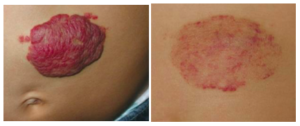What is infantile hemangioma?
Hemangiomas affect 4-5% of infants and consist of collections of abnormal blood vessels that cluster together as a tumor. They may be visible on the skin of the face and body, or deep in the body in liver or other organs, and consist of many subtypes not all of which behave the same. Infantile hemangiomas (IH) are the most common subtype. The skin lesions appear red, firm, and warm. They are not present at birth and are diagnosed commonly at age 1-2 months by the history and appearance. Biopsy is rarely needed and imaging is not usually necessary.
Will it need treatment?
The lesion grows (proliferates) for an average of 5 months, stabilizes by 6 months of age, and then shrinks down (involutes) over the next 2-3 years. Regrowth does not occur but faint scarring or redundant skin may be seen in half of patients. (see photos below, showing an IH)

If IH involves the airway, is around the eye affecting vision, is large or is bleeding then treatment is indicated, otherwise most will resolve on their own.
